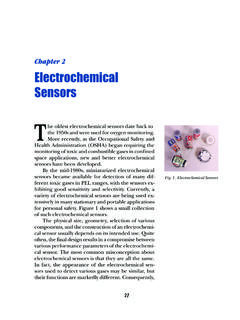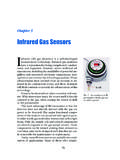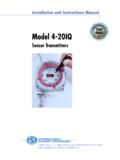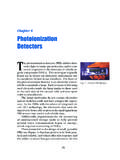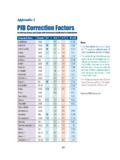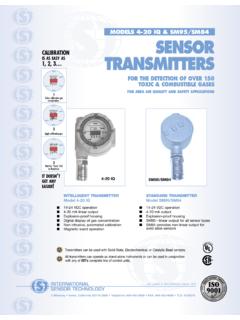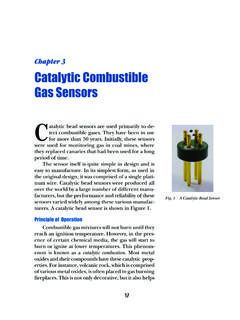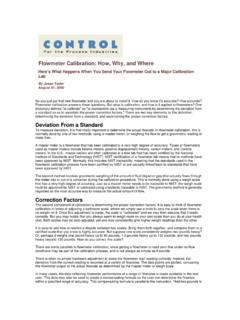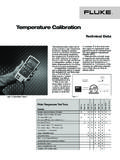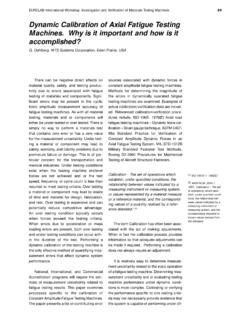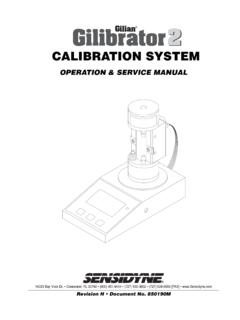Transcription of Gas Sensor Calibration
1 161 Chapter 11 Gas Sensor CalibrationChapter 11 Gas Sensor CalibrationGas sensors need to be calibrated and periodi-cally checked to ensure Sensor accuracy andsystem integrity. It is important to install station-ary sensors in locations where the Calibration can beperformed easily. The intervals between calibrationcan be different from Sensor to Sensor . Generally, themanufacturer of the Sensor will recommend a timeinterval between Calibration . However, it is good gen-eral practice to check the Sensor more closely duringthe first 30 days after installation. During this period,it is possible to observe how well the Sensor is adapt-ing to its new , factors that were not accounted for in thedesign of the system might surface and can affect thesensor s performance. If the Sensor functions prop-erly for 30 continuous days, this provides a good de-gree of confidence about the installation.
2 Any possibleproblems can be identified and corrected during thistime. Experience indicates that a Sensor surviving 30days after the initial installation will have a goodchance of performing its function for the durationexpected. Most problems such as an inappropriatesensor location, interference from other gases, or theloss of sensitivity will surface during this the first 30 days, the Sensor should bechecked weekly. Afterward, a maintenance schedule,162 Hazardous Gas Monitorsincluding Calibration intervals, should be , a monthly Calibration is adequate to ensurethe effectiveness and sensibility of each Sensor ; thismonthly check will also afford you the opportunity tomaintain the system s method and procedure for calibrating thesensors should be established immediately. The cali-bration procedure should be simple, straightforward,and easily executed by regular personnel.
3 Calibra-tion here is simply a safety check, unlike laboratoryanalyzers that require a high degree of accuracy. Forarea air quality and safety gas monitors, the require-ments need to be simple, repeatable, and economi-cal. The procedure should be consistent and trace-able. The Calibration will be performed in the fieldwhere sensors are installed so it can occur in any of the gas Sensor involves two the zero must be set and then the span mustbe One: Setting the Zero ReadingThere is no established standard that defines zeroair. Many analytical procedures, including some spe-cific analyzer procedures such as EPA methods, usepure nitrogen or pure synthetic air to establish thezero point. The reason for this is that bottled nitro-gen and pure synthetic air are readily available. As aresult, it is popularly believed that using bottled nitro-gen or synthetic air is a good method to zero a , this is not correct.
4 Normal air con-tains traces of different gases besides nitrogen andoxygen. Also, ambient air normally contains a smallpercentage of water vapor. Therefore, it is much morerealistic and practical to zero the Sensor using theair surrounding the Sensor when the area is consid-ered to be clean. This reference point can be diffi-cult to establish. Therefore, a good reference point163 Chapter 11 Gas Sensor Calibrationcan be in the area where air is always consideredclean, such as in an office area. This will give a morerealistic representation of the zero point because itwill be representative of the local ambient air condi-tion. The lack of water vapor can cause the zero pointsetting to read lower than in ambient air making thesensor zero appear to drift. This is most noticeablein solid-state sensors and Methods.
5 Taking all factors such as thetype of Sensor and the conditions of the applicationinto consideration, the following are some proposedmethods of Calibration :A. In applications where the ambient air is nor-mally clean, and, based on the operator s judgmentthat no abnormal condition exists and the instrumentis indicating a close to zero reading, the procedure tozero the Sensor can be skipped. When in doubt, use aplastic bag to get a sample of what is considered to be clean air in the facility and expose it to the sensorfor a few minutes. This is a very quick and easy proce-dure. It is also a very effective way to differentiate areal alarm from a false Compressed air has the advantage that it is easyto regulate and can be carried around in a bottle. Also,in many facilities, shop air is available throughout theplant, making it very accessible and convenient.
6 How-ever, most shop air contains small concentrations ofhydrocarbons, carbon monoxide, carbon dioxide, andpossibly other interference gases. Also, the air is typi-cally very low in humidity. A solution to this is that theair can be filtered through activated charcoal to re-move most of the unwanted gases and water vapor canbe added into the air using a humidifier in the sam-pling system. After this conditioning, the air can beused to calibrate most types of sensors. However, it isimportant to note that carbon monoxide is not re-moved by charcoal is therefore imperative to make sure that theN2O2H2 OCO2 & othersAmbient air is the best zero Gas MonitorsCO concentration in the shop air is the same as in theambient air. Furthermore, a soda ash filter should beused to remove carbon dioxide. This is also a very goodway to zero carbon dioxide sensors since placing a sodaash filter in-line with the sampling system will removeall carbon dioxide, thus providing an easily obtain-able zero synthetic air is usually very pure, it can-not be used with solid-state sensors or PID sensorsbecause these sensors require some water vapor in thesample stream.
7 A simple solution to this problem is toadd a wet tissue paper in the sample line. This acts asa humidifier in the sample stream and providesenough water vapor for the Sensor to read option is to use a Nafion tube, which is de-scribed thoroughly in Chapter 10, Sampling Systemsand Designs. Figure 1 illustrates this 1 Adding Moisture to Calibration GasesStep Two: Span CalibrationThe span Calibration can be quite easy or it can bevery complicated and expensive, depending on the gastype and concentration range. In principle, to achievethe best accuracy, a mixture of the target gas balanced in thebackground environmental air is the best Calibration , although this can be done, it usually requiresthat the operators be more skilled than would usuallybe required. In practice, most Calibration gases are pur-chased from commercial suppliers.
8 The following sec-tion describes a few methods of span Premixed Calibration GasCalibration GasRegulatorNafionDryer Tube orWetting MaterialTo SensorFlowMeter165 Chapter 11 Gas Sensor CalibrationThis is the preferred and most popular way to cali-brate gas sensors. Premixed gas mixtures are com-pressed and stored under pressure in a gas bottle. Thebottles are available in many sizes but most field cali-brators employ smaller, lightweight bottles. Thesesmall portable bottles come in two different catego-ries: a low-pressure and a high-pressure low-pressure bottles are thin-walled, light-weight bottles that are usually nonreturnable and dis-posable. High-pressure bottles are designed to bottlepure hazardous chemicals. For Calibration gases, thesebottles are normally made of thick-walled aluminumwhich has a service pressure of 2000 get this highly pressurized gas out of the bottlein order to calibrate the Sensor , a regulator assemblyis needed.
9 This assembly consists of a pressure regu-lator, a pressure gauge, and an orifice flow orifice flow restrictor is a fitting with a hairlinehole that allows a constant air flow at a given pres-sure difference. In operation, the high pressure fromthe bottle is reduced to a lower pressure of only a fewpsi, which provides a constant air flow through theorifice. Flow rates between 600-1000 cc/min are most common. Models can befitted with an adjustable pressure regu-lator so that the flow rate can be adjustedaccordingly. Figure 2 illustrates typicalmodels of high- and low-pressure gases can be premixed withair and stored under pressure, but somegases can only be mixed in inert gasbackgrounds, such as nitrogen. Somemixtures can only be stored in bottlesthat are specially treated or condi-tioned. Each type of mixture will havea different amount of time before it ex-pires or before it can no longer be used.
10 Low-Pressure Assembly High-Pressure AssemblyFig. 2 Calibration Gas Bottles166 Hazardous Gas MonitorsDetailed information about storage and shelf life canbe obtained from the manufacturer. Generally, highvapor pressure gases with low reactivity, such as meth-ane, carbon monoxide and carbon dioxide, can bemixed with air and stored under high pressure. Lowvapor pressure gases, such as liquid hydrocarbon sol-vents, can only be mixed with air and stored underlow pressure. Most highly reactive chemicals are mixedwith a nitrogen background. With certain sensors, suchas solid-state sensors, whether the mixture of the gasis in the air or in the nitrogen background will dra-matically affect the Sensor Calibration , some sensors may need mois-ture to get a proper reading. Moisture can be added byfollowing the same procedure described in Step 1 forzeroing the estimate the volume of a pressurized gas in acylinder, take the total pressure (P) divided by the at-mospheric pressure (Pa) and multiply this ratio by thevolume of the cylinder:Vmix= V.
